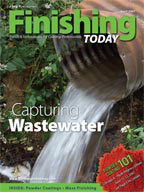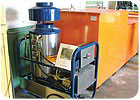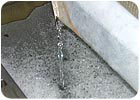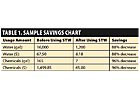
TASROP, Inc., Florence, CO, is one of the largest-capacity powder coating job shops in southern Colorado. Founded by Robert Miller in 1998, the company coats a variety of parts, ranging from small, decorative cement frogs to 5,000-lb steel mounting platforms for computer systems. Its powder coating operation accounts for about $100,000 in sales per year.
The company wasn’t always a powder coater. According to Miller, TASROP spray painted most of the parts it handled the first few years it was in operation. It wasn’t until 2001 that the company decided to switch to powder coatings. “We had some products that we had to powder coat for a company. When we did that, we discovered that powder coatings were a much safer and more environmentally responsible alternative to spray paint, so we switched completely to powder coatings,” says Miller.
TASROP received a commendation from the U.S. Environmental Protection Agency (EPA) and the Colorado Department of Public Health for its action. But for Miller, who describes himself as an “environmentalist to the core,” the change didn’t go quite far enough. While the powder coating operation was environmentally friendly, the company still had to deal with the high costs and environmental impact associated with maintaining and operating product pretreatment systems and disposing of wastewater.
“We were spending $1500 minimum per month for replacement pretreatment chemicals. At the time, regulations did not prohibit us from sending our wastewater down into our leach field, and the local health department told us that our wastewater could be discharged down the drain. But we weren’t comfortable with that option, and we knew that the EPA would eventually tighten wastewater discharge requirements,” Miller explains.
A local drought proved to be the last straw. “I was on the local water board, and we had to ration people’s water because of the drought. It’s hard for a businessman to justify rationing people’s water if he can’t ration the water in his own company,” Miller says.

A typical jobshop unit measures 3 x 3 x 8 ft, and all connections are made with basic water hoses.
Saving the Water - and the Chemicals
Miller was determined to find a solution, but there didn’t appear to be any technology available to accomplish the job. So in 2002, he set out to create his own system. The resulting equipment, which he called the Save the Water (STW) recycling system, reduced his water usage from 16,000 gallons of water per month to 1200 gallons per month, and from three barrels of chemicals per month to one and a half barrels per year - a 90% savings on water and chemicals.Miller designed the system to be small and simple. A typical jobshop unit measures 3 x 3 x 8 ft, and all connections are made with basic water hoses. The unit is installed between the washbay or vat and the power washer. The system processes the contaminated water and chemical solutions out of the washbay or vat through its proprietary filtration system, then refilters the solution continually and pumps it back into the power washer/cleaning system. By filtering chemicals and recycling the water, the system provides greater control over the chemical-to-water ratio (including the pH level and the amount of phosphate cleaning agent in the water-chemical solution), thereby enhancing cleaning capabilities. Instead of having to neutralize and dispose of the water- chemical solution, the solution is continually filtered and recycled for optimal performance at a fraction of the cost.
Miller calculated that a company using 15,000 to 18,000 gallons of water and 165 to 185 gallons of chemical cleaning agent per month could decrease its usage to less than 1,200 gallons of water and 7 gallons of cleaning agent per month by using the new recycling system. Based on that model, a small business could potentially save $17,000 per year. Miller believed he had stumbled onto an environmental gold mine.
After seeing the results of laboratory and site testing, the EPA agreed. Marie Zanowick, P2 Expert, Office of Pollution Prevention (P2), U.S. Environmental Protection Agency, wrote in a letter to Robert Miller, “You are to be commended for the environmental approach to your powder coating system. Your business has set a standard that I hope other businesses in Colorado will follow.”
And follow they did. One of the technology’s first adopters actually came from outside the powder coating industry. The Colorado Department of Transportation had been forced to close the floor pits in some of its maintenance facilities because of the pollutants that run off the trucks. After reading about the new recycling system in a local newspaper article, the agency decided to try it. The system was so effective that the resulting water met surface water discharge standards.
“Prior to installing the system, these facilities were having to pay for hazardous waste disposal, so they were able to reap a significant cost savings,” says Miller.
In the fall of 2004, TASROP was recognized by the Colorado Department of Public Health with an Environmental Achievement Silver Award certificate for its new technology. It was also notified that EPA’s Region 8 had begun “encouraging all transportation agencies in Region 8 to use the STW systems.”

At an outside test site, the STW recycling system turned pit water with multiple pollutants (above)into Class 2 Drinkable Water (see photo below left) in minutes for a cost of approximately $7/day.
Improving the Finishing Environment
Nearly 1000 miles away, in Elk Point, SD, another company was taking notice. AaLadin Industries, which manufactures and powder coats high-pressure cleaning systems for a variety of industries, was looking for a technology that would decrease both the wastewater discharge and chemical usage in its phosphatizing operation. After testing the STW system for nearly two years, the company experienced such a substantial savings in pretreatment chemicals, wastewater disposal and overall water consumption that it was eager to share the technology with other companies. In January 2007, Aaladin Industries entered a licensing partnership with TASROP to become the exclusive retailer of the STW recycling system to the powder coating industry.“The system was an ideal fit with AaLadin’s power washers, which are used by a number of powder coaters,” says Miller. “The intent is to enable companies to use the savings from the STW to be able to pay for both pieces of equipment in a very short period of time.”

Water filtered through the STW recycling system.
The system, which is now covered by five patents with five additional patents pending, has been proven to reduce aluminum, zinc, lead, chloride and arsenic and other heavy metals in reusable water. Additional testing is ongoing. Miller believes the technology will eventually find use in a range of applications, from vehicle maintenance facilities and manufacturing plants to farms and ranches, natural resource preservation, and other industrial and agricultural organizations.

Reaping the Payback
As with any technology, the new recycling system requires an upfront capital investment. The system also requires proprietary filters, which must be replaced at regular intervals to keep the equipment performing at its optimum efficiency. According to Miller, the lifecycle of the filters depends on the filtration volume. Small operations that handle only a few gallons per minute of chemical solution might spend less than $1200 per year on replacement filters, while large facilities that process up to 34 gallons per minute might need to spend $3600 or more. However, Miller says that these costs are minimal compared to the savings that can be achieved with the recycling system.“I know of two finishing companies that were fined twice in two years, $3000 each time, because their pollutants going down the drain were too heavy,” he says. “In my case, changes made over the past several years to the Class V Underground Injection Well rule would now prohibit me from discharging my wastewater outdoors if I didn’t have the STW system. I would have to pay to have my wastewater hauled off, and that would cost me about $400-500 per month. That doesn’t even include the cost of replacement chemicals or water consumption.”
Miller also notes that some communities offer tax breaks as water saving incentives. Based on these benefits, he estimates that most companies can see a return on their investment in as little as six months (see Table 1). As part of TASROP’s “performance guarantee,” the company in many cases allows users to finance the bulk of the purchase price based on the actual savings provided by the system.
Ultimately, however, Miller believes that the potential payback on the recycling system is about more than just the bottom line dollar figure.
“Water pollution is a serious problem,” says Miller. “This technology can help protect our natural resources.”
For more information about TASROP or the recycling system, call 877.784.3712 or 719.784.3712, e-mail tasrop@amigo.net, or visit www.tasrop.com.
AaLadin Industries can be reached at 800.356.3325 or 605.356.3325, info@aaladin.com or www.aaladin.com.

Report Abusive Comment